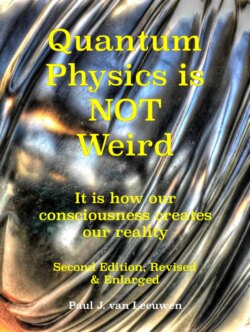Оглавление
Paul J. van Leeuwen. Quantum Physics is NOT Weird
Preface
Reading guide
Quantum Physics in science and in the media
1: Paradoxes – ‘I know how it works’
The Ames room, how our brain deceives us
2: The discovery of the solar system
The geocentric Ptolemaic model
The heliocentric model of Copernicus, Galilei and Kepler
Sir Isaac Newton (1643 – 1727)
Zeno of Elea (ca. 490 BC) and his paradoxes
Pierre-Simon Laplace (1749-1827)
Light as little hard balls or as waves
What we learned in this chapter:
3: The clockwork universe and the ether
Light as a wave phenomenon, interference, superposition
Fields, electromagnetic waves
A Nobel prize for a failed experiment
The classical view of the universe at the end of the 19th century
The electromagnetic spectrum
The UV catastrophe and Planck’s quantum
A desperate act
What we learned in this chapter:
4: The collapse of classical physics
Waves
Einstein’s photons
Ernest Rutherford’s model of the atom
The solar system model of the atom is impossible
Energy is equal to mass according to Einstein
Spectral lines. Niels Bohr quantizes the atom
Harmonic electron waves
Diffraction grids, series of parallel slits
Serendipity with electrons
The birth of the electron microscope
What we learned in this chapter:
5: Uncertainty, the quantum collapse
Double-slit with single electrons or photons
Observing the slits .. or not
The quantum mechanics – Heisenberg and Schrödinger
Subjective and objective probabilities
Einstein’s recoiling slit ‘Gedanken’ experiment
Einstein’s recoiling slit experiment at the molecular level
The molecular double-slit results
It’s all about information
The Copenhagen interpretation
Wonderful Copenhagen
Schrödinger’s cat and the measurement problem
Snapshots of state waves
What we learned in this chapter:
6: An obscuring forest of hypotheses
Known and hidden variables
Local and non-local
The projection postulate by John von Neumann
Einstein's last attack – the EPR paradox
Entanglement
A non-local quantum theory
Bell’s theorem
Bell test, test, test, .. and success, success, success, .
Eight popular quantum hypotheses
1: Hidden variables
2: Multiverse hypothesis
3: Spontaneous collapse
4: Super selection
5: Decoherence
6: The Matrix
7: No collapse
8: Projection postulate
Seven critical experiments
1: Fullerene interference
2: Pk-experiments
3: The quantum Zeno effect
4: The Davisson Germer experiment:
5: Double-slit pk-experiment
6: Two observers quantum collapse experiment
7: Photosynthesis efficiency
Summarized result of 8 experiments
Bohr’s complementarity
What we learned in this chapter:
7: The delayed choice experiments
John Wheeler’s thought experiments
The Mach-Zehnder interferometer
Wave reflections and phase shifts on beamsplitters
Closed Mach-Zehnder explained with light waves
Closed Mach-Zehnder explained by photons
Closed Mach-Zehnder explained by the state wave
The quantum information eraser
Open Mach-Zehnder configuration
Delayed choice Mach-Zehnder experiments
Wheeler’s Mach-Zehnder experiment with cold atoms
The blocked Mach-Zehnder
The delayed quantum eraser experiments with light
Delayed choice two-photon quantum eraser
Delayed choice quantum eraser results discussion
Does the entangled state wave collapse completely?
Is consciousness at stake here?
Final conclusions of the delayed choice experiments
Starlight
The quantum picture of a light wave
A quantum radar
What we learned in this chapter:
8: Information, Communication, Entropy
Communication between Bob and Alice
Information and entropy
Entropy, order, chaos, and information
Time, space, and entropy
An information eraser
What we learned in this chapter:
9: The dubious existence of the photon
Do photons exist, actually?
Energy conservation and photons
Reification of the abstract photon
What we learned in this chapter:
10: Retrocausality in physical reality
Sensing the future
Experiments on premonitions
The quantum wave and the time
What we learned in this chapter:
11: Quantum biology
Quantum tunneling
Quantum biology has become respectable science
Quantum tunneling in living systems. Breath in, breath out
A chlorophyll quantum computer
Enzymes
Quantum tunneling neurons
The robin’s magnetoreception
Quantum smelling
DNA
The origin of mutants
The quantum brain
Information, entropy, life and consciousness
Life and the multiverse
Quantum coherence
What we learned in this chapter:
12: The matter of mind
The Cartesian Duality
The Cartesian theater
You’re not in there, not even now
The rubber hand illusion
The body-swap illusion
The quantum as phantom
The thought is the thing
Entanglement is a thought
Non-locality of thought
Models of consciousness and reality
Awareness as an emergent phenomenon
The Cartesian body-consciousness duality
Monistic consciousness
Cosmic consciousness - OMMIR
The Omkar
All quantum paradoxes disappear
The illusion of time and distance
In good company
The 7 Principles of Biocentrism
What we learned in this chapter:
13: Testing the theory
The quantum Zeno-effect
Adapted quantum eraser
Synchrotron-Soleil experiment
Demonstrating awareness in animals and plants
Quantum computers and consciousness
What we learned in this chapter:
14 Consilience
Near-Death Experiences
After death communications
Children with memories of past lives
Verified communications with deceased persons
Psychokinesis: consciousness influencing the physical
The astounding effectiveness of mathematics
15 Some assorted thoughts
Dark matter, antimatter, and anti-time
Where is this anti-universe located?
Google claims to have reached quantum supremacy
Multiverse hypothesis incompatible with the double slit. Hugh Everett’s proposition – everything that is possible, happens
The double-slit as test
Nevertheless, light is made up of particles
Photons and the quantum state wave
The undoing of the multiverse – the continuity of the interference pattern
Observing the slit makes the multiverse split
Is this still plausible?
A radical change in perspective
Schrödinger’s stopwatch. A rhetorical trick
A physically correct thought experiment
The observer creates matter in time
16 The trodden path
Epilogue
Appendices. A: Observers in physics
B: Faster than light communication with the quantum eraser?
C: Waves, phases, and frequency
D: Locality and fields
E: A short introduction to complex numbers
F: The multiverse hypothesis, what it means in numbers
G: Coherence and decoherence
H: The cat who told me she was all right
H: Bibliography
I: How this book came about
Notes
Glossary
